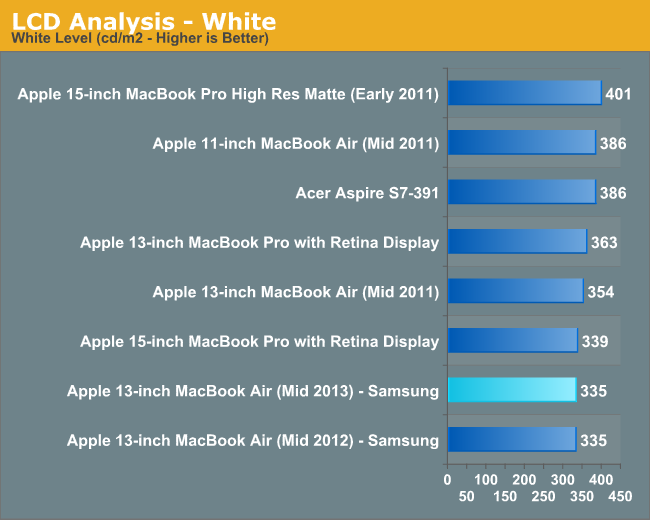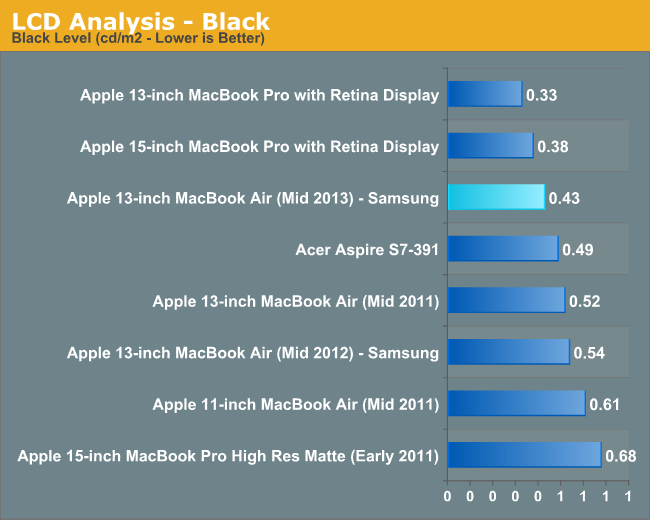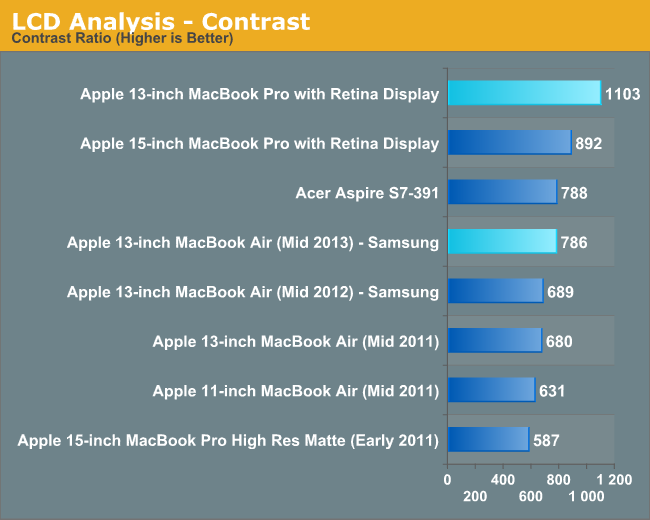The 2013 MacBook Air Review (13-inch)
by Anand Lal Shimpi on June 24, 2013 12:01 AM ESTDisplay
When I reviewed the 13-inch MacBook Pro with Retina Display, I viewed it as the true Retina MacBook Air that everyone was waiting for. With modest increases in thickness and weight, the rMBP13 gave you a much better screen and a larger battery to drive it. Apple’s lineup made sense.
After being in Taiwan earlier this month and checking out all of the 13.3-inch 2560 x 1440 displays being used on notebooks similar in size to the 13-inch MBA, I was beginning to reconsider my position.
To hit an aggressive schedule, you have to mitigate risk. In the case of the 2013 MBAs, Apple kept the chassis spec unchanged in order to do just that. As a result, the displays too, remained unchanged. We’re talking about TN panels (admittedly higher quality than most) and traditional pixel densities. Compared to the Retina Displays deployed across the rest of Apple’s product lines, these panels just aren’t as good. Compared to what you typically find elsewhere, they’re still among the best.

There are two aspects to deploying a Retina Display in a MacBook Air that are worth discussing. The first is power consumption. Greater pixel density requires a more powerful backlight to drive the panel at the same brightness, which in turn reduces battery life. Apple’s solution is to deploy Retina Displays on products it can outfit with a sufficiently large battery. I’d argue that given the battery life of the 2013 MBAs, Apple could move to a Retina Display and still deliver reasonable battery life - but it would be a regression.
The second thing to consider is price. I don’t know just how much more a Retina Display would add to the cost of a MacBook Air, but it’s clear it would be non-negligible.
There’s no real solution to the first problem, but the second one should be less of an issue as panel prices come down. I don’t know where Apple will eventually land on all of this, but today what happens is we get a well defined separation between MacBook Air and MacBook Pro with Retina Display.
Professional users who need greater color accuracy and/or additional desktop resolution really should go for the MacBook Pro with Retina Display. If you don’t need either, the MacBook Air will suffice.
In practice, the MBA’s display isn’t bad by any means. I’ve been staring at it non-stop since WWDC and don’t mind using it at all. The biggest visual issue for me is actually the shifting contrast at off-center vertical angles. It’s not a problem once you properly adjust the display angle but it’s something you don’t have to deal with on the rMBPs. When I'm not in crazy work mode, the lack of resolution isn't a huge deal - but when putting together big articles like this one, I find myself missing the rMBP quite a bit. I guess that's why the rMBP has Pro in the name.



My review sample featured a Samsung panel (LSN133BT01A02), although I’m sure the usual panel lottery is in full effect this generation as it has been in the past. Brightness and contrast are both comparable to what we had last generation (my Samsung panel this year was a bit better than last year's). The brightness/contrast results are very comparable to Acer's 1080p S7, just to show you how far Ultrabooks have come.
I ran the 2013 MBA through Chris Heinonen’s new display workflow using CalMAN to give you an idea of color accuracy vs. the rMBP:



| CalMAN Display Comparison | ||||||||
| Apple iPad (3rd gen) | Apple iPhone 5 | 13-inch rMBP (uncalibrated) | 13-inch 2013 MBA (uncalibrated) | Google Chromebook Pixel | ||||
| Grayscale 200 nits Avg dE2000 | 3.7333 | 3.564 | 1.7825 | 3.348 | 7.132 | |||
| CCT Avg (K) | 6857K | 6925K | 6632K | 6809K | 6442K | |||
| Saturation Sweep Avg dE2000 | 3.193 | 3.591 | 2.1663 | 5.3608 | 7.0927 | |||
| GMB Colorchecker Avg dE2000 | 3.0698 | 4.747 | 2.4521 | 3.9883 | 5.7664 | |||
The 13-inch MacBook Air isn’t bad, but Apple’s Retina Display is just better.













233 Comments
View All Comments
ananduser - Monday, June 24, 2013 - link
I believe this is the first time a company has actually released a slower product than the previous gen. On principle at least Apple should be penalized in the review.Anand may I suggest a battery testing feature ? Count the time it takes to finish one iteration of the looping test. Maybe the battery lasts longer on a certain device but it may also take longer to finish the task. After that "normalize" the results to really measure the improvement.
Paapaa125 - Monday, June 24, 2013 - link
MBA 2013-mid is not really that much slower. It has a lot faster SSD, it has a lot faster WLAN. CPU equal or slower than previous and GPU is faster than previous models. For most usages the net result is a equally fast if not faster computer. Mostly because SSD.captainBOB - Tuesday, June 25, 2013 - link
Instead of going the typical route and using all the extra power savings to increase performance while maintaining the same battery life of last year's model, Apple decided to increase battery life while maintaining performance with last year's model. Its an ultraportable.If you want more juice, get a Macbook Pro, the Macbook Air is all about the ultraportability.
As for the lack of 1080p, on all those other ultrabooks with a 1080p screen, the DPI scaling is upped to 150% by default because people were complaining that text on the screen was too small, Windows still can't handle DPI scaling very well, and I doubt Windows 8.1 will change things because it will most likely be an API and still be up to the developer to update their programs to support higher resolutions. Given the "stellar" track record of the Windows desktop development community and Microsoft itself in actually USING the awesome new APIs that Microsoft creates. The situation isn't going to change the moment 8.1 comes out, it may not change for several years.
Retina may be in the Air's future, but for now the Retina display is what clearly separates the Pro from the Air.
If there is one criticism that is valid, its that the display should've been at least IPS.
ananduser - Tuesday, June 25, 2013 - link
Spare me the marketing talk please...I never mentioned anything about the screen. Why do you feel the need to explain me Apple's motives for that ?They could have very well provided a 9 hour machine with a tangible increase in performance, but hey, Apple fans don't care, everything is perfect in camp Cupertino.
PS: Since you brought it up, the Windows desktop development community is pretty stellar indeed; it's why the best software on the planet, from virtually all categories you wish to name, is made to run on Windows first and foremost. Windows(the software) always handled scaling very well, and having options like 125% or 150% is pretty nifty. Since the display pissing contest just started it will take some time until devs start to obey proper guidelines.
Paapaa125 - Tuesday, June 25, 2013 - link
It's always a tradeoff. Apple went now for maximal battery life with acceptable performance. Most likely they'll focus on performance with rMBP. Sounds logical to me. I think there are many users to whom MBA has enough CPU power and they really need all day battery life. MBA now barely delivers that. Lower battery life would've meant that it will not last all day.ananduser - Wednesday, June 26, 2013 - link
So...we Anandtech readers... we who are the most pretentious of most users... can't we provide criticism ?jmmx - Monday, June 24, 2013 - link
What would like to know is this...I assume that turbo boost speeds will more likely occur when the unit is plugged in - i.e. it will not be draining the battery. Do any of these tests take this into account? (or did I jut not read far enough yet?)
Laststop311 - Monday, June 24, 2013 - link
I totally despise apple and yes it looks like they are making a lot of mistakes with the 2013 refresh. Staying with low res screens and lower clocked processors that are actually a nudge slower than in 2012. But with the the lower clock speeds and massive battery life improvements of the haswells the macbook air is poised to be the longest running ultrabook on battery this year, especially with the larger battery that adds no weight.When you combine the fact that this is haswell, they stayed with low res screens added a larger battery and lowered the cpu frequencies we are in for a real treat with an ultrabook with an insane battery runtime that still has enough power to do everything an ultrabook is used for 99% of the time and do it it with performance in the mid the to midhigh pack with Top battery scores. Not to mention the thermals are probably so much cooler on this air. If Apple left it at 50% would would or probably seen 15 hour idle numbers from apple. And once OSx integrates the power management optimizer feature from haswell those battery life numbers will only go up. Eve more.
I hate apple. But if battery life i you're #1 concern and want to routinely pull 10 hour workdays from your machine without charging the macbook air 13 model 2013 is the ultrabook for you.
KPOM - Thursday, June 27, 2013 - link
All notebooks are about design compromises. Apparently Apple decided to tweak this one for battery life rather than use Haswell as an opportunity to put in a faster processor or better screen. Hopefully they'll find a way to shave a few ounces off the weight of the 13" rMBP. I have one and like it, but miss the portability of the Air.Laststop311 - Monday, June 24, 2013 - link
I wish sata would just completely die off and intel increased in PCI lines by double 80X on enterprise 32x on consumer and have all new HDD and SSD connect via PCI 3.0 1GB/SEC bi directional. Can just use 1x lanes for all the storage devices maybe a few 2x lane connections for super high performance ssd;s. But probably won't see this wish till 2GB/sec bi directional pcie-e 4.0. Where we can easily stack up 8 SSD's on 1s lanes while still providing enough lanes for full GPU use. I hope pci 4.0 brings the full death of sata and its outdated ways. Even if we have to call it sata express. The Use of SATA needs to be fully dead by pci-e 4.0. Yea that includes even having to run a practically obsolete blu ray burners off a 1x line but who knows by then there may be a disc much puerior yo blu ray that can actually use the extra bandwidth. Would simplify computers no longer having to have all that data hardware on there too.